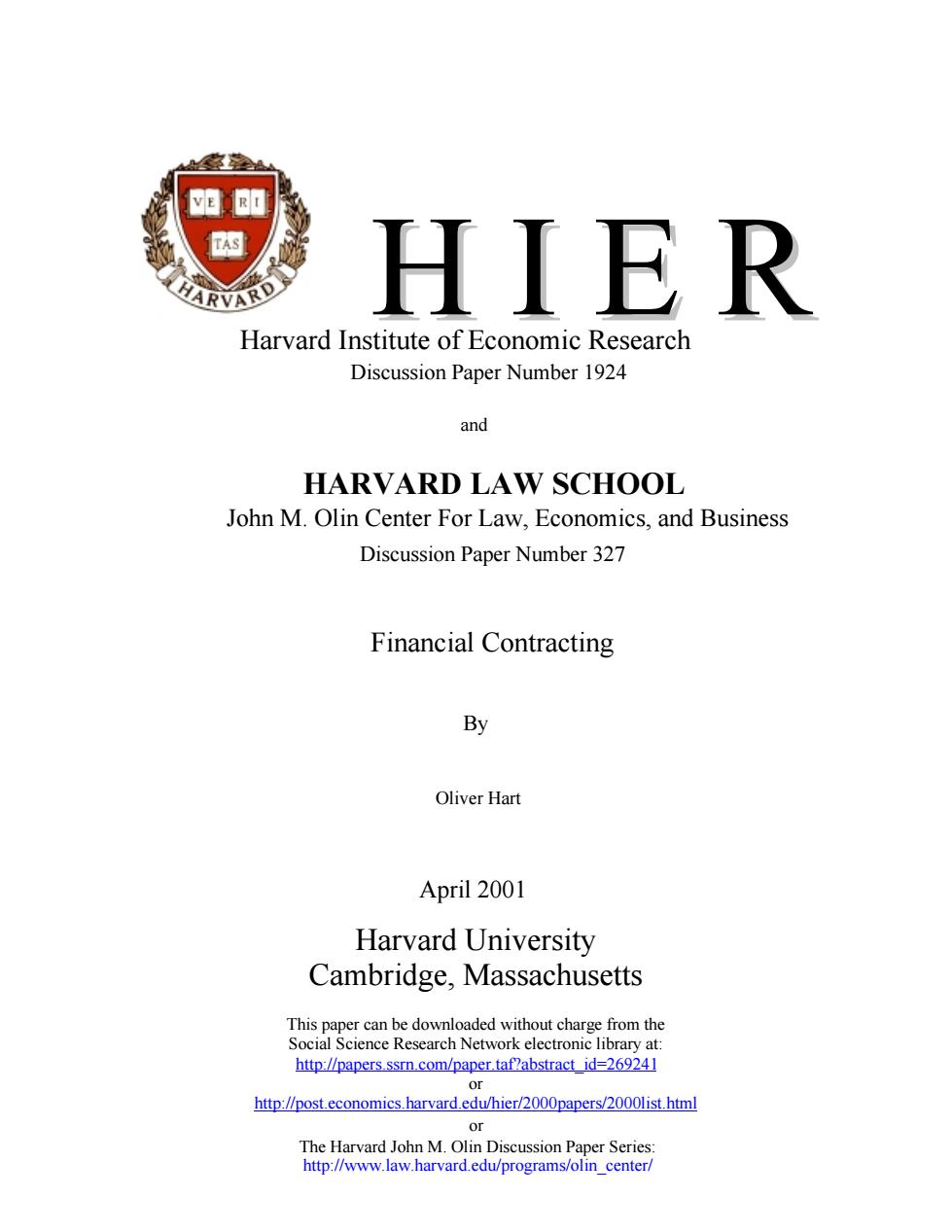
ARVARD HIER Harvard Institute of Economic Research Discussion Paper Number 1924 and HARVARD LAW SCHOOL John M.Olin Center For Law,Economics,and Business Discussion Paper Number 327 Financial Contracting By Oliver Hart April 2001 Harvard University Cambridge,Massachusetts This paper can be downloaded without charge from the Social Science Research Network electronic library at: http://papers.ssrn.com/paper.taf?abstract id=269241 or http://post.economics.harvard.edu/hier/2000papers/2000list.html or The Harvard John M.Olin Discussion Paper Series http://www.law.harvard.edu/programs/olin center/
H I E R By April 2001 Harvard University Cambridge, Massachusetts This paper can be downloaded without charge from the Social Science Research Network electronic library at: http://papers.ssrn.com/paper.taf?abstract_id=269241 or http://post.economics.harvard.edu/hier/2000papers/2000list.html Financial Contracting Oliver Hart Harvard Institute of Economic Research Discussion Paper Number 1924 or http://www.law.harvard.edu/programs/olin_center/ The Harvard John M. Olin Discussion Paper Series: HARVARD LAW SCHOOL John M. Olin Center For Law, Economics, and Business Discussion Paper Number 327 and
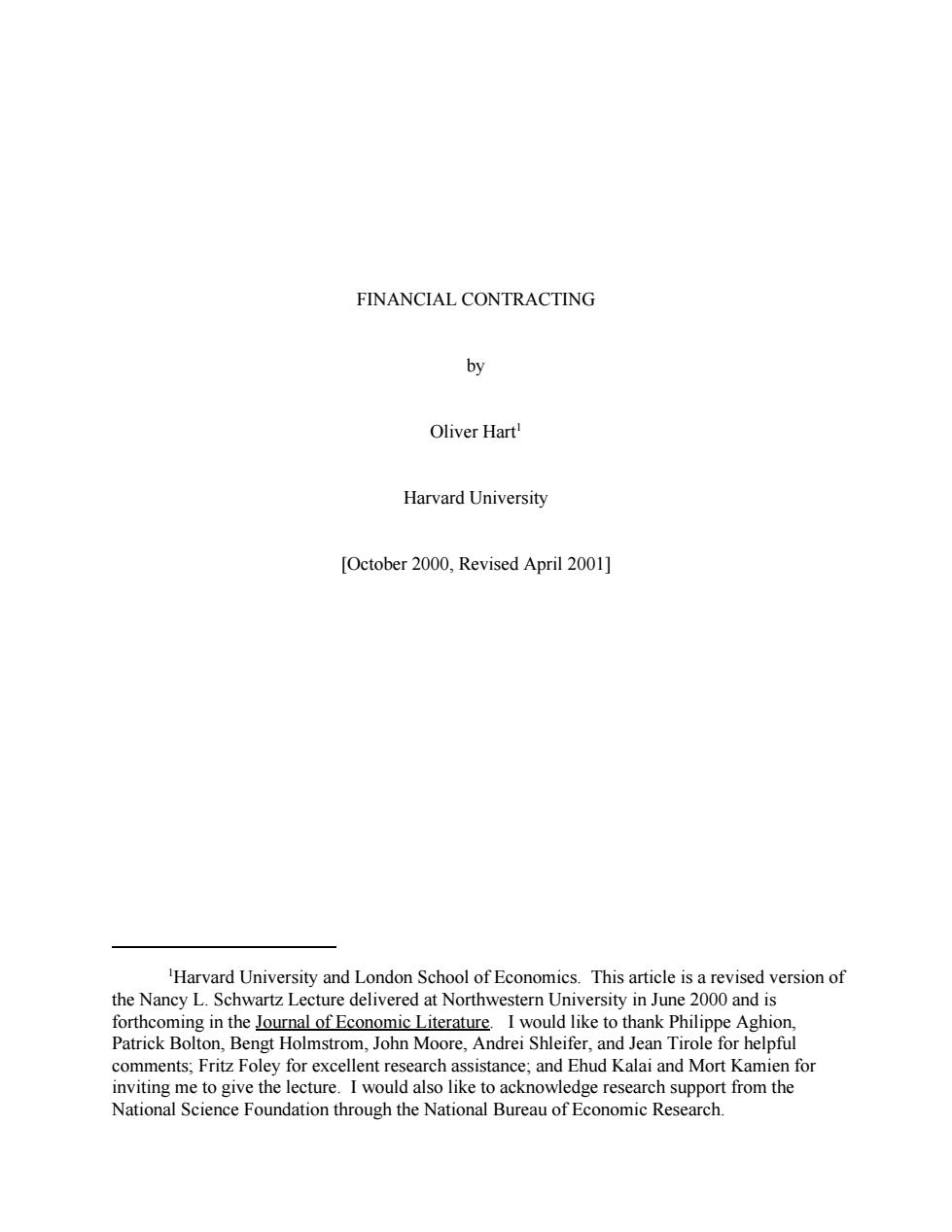
FINANCIAL CONTRACTING by Oliver Hart' Harvard University [October 2000,Revised April 2001] Harvard University and London School of Economics.This article is a revised version of the Nancy L.Schwartz Lecture delivered at Northwestern University in June 2000 and is forthcoming in the Journal of Economic Literature.I would like to thank Philippe Aghion, Patrick Bolton,Bengt Holmstrom,John Moore,Andrei Shleifer,and Jean Tirole for helpful comments;Fritz Foley for excellent research assistance;and Ehud Kalai and Mort Kamien for inviting me to give the lecture.I would also like to acknowledge research support from the National Science Foundation through the National Bureau of Economic Research
1Harvard University and London School of Economics. This article is a revised version of the Nancy L. Schwartz Lecture delivered at Northwestern University in June 2000 and is forthcoming in the Journal of Economic Literature. I would like to thank Philippe Aghion, Patrick Bolton, Bengt Holmstrom, John Moore, Andrei Shleifer, and Jean Tirole for helpful comments; Fritz Foley for excellent research assistance; and Ehud Kalai and Mort Kamien for inviting me to give the lecture. I would also like to acknowledge research support from the National Science Foundation through the National Bureau of Economic Research. FINANCIAL CONTRACTING by Oliver Hart1 Harvard University [October 2000, Revised April 2001]
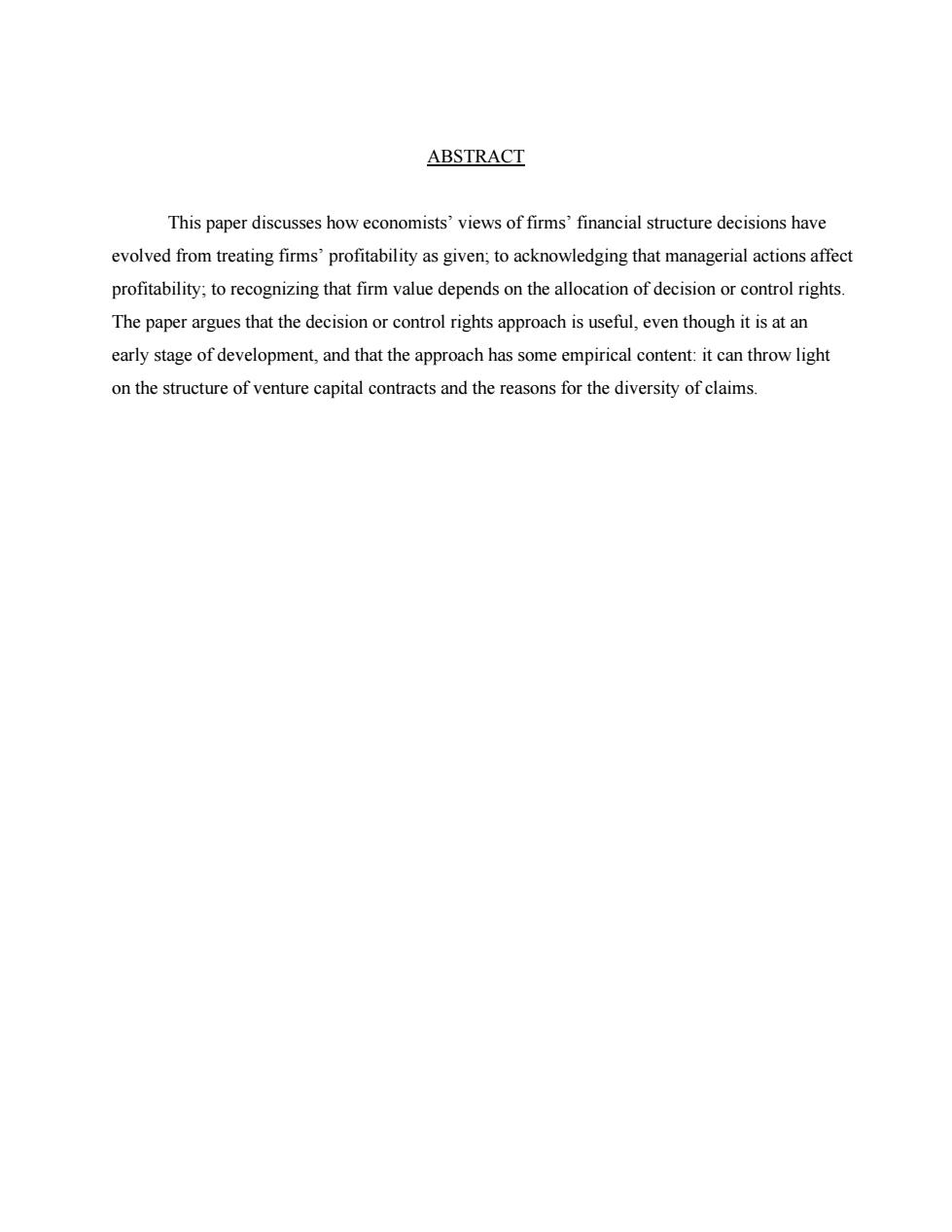
ABSTRACT This paper discusses how economists'views of firms'financial structure decisions have evolved from treating firms'profitability as given;to acknowledging that managerial actions affect profitability;to recognizing that firm value depends on the allocation of decision or control rights. The paper argues that the decision or control rights approach is useful,even though it is at an early stage of development,and that the approach has some empirical content:it can throw light on the structure of venture capital contracts and the reasons for the diversity of claims
ABSTRACT This paper discusses how economists’ views of firms’ financial structure decisions have evolved from treating firms’ profitability as given; to acknowledging that managerial actions affect profitability; to recognizing that firm value depends on the allocation of decision or control rights. The paper argues that the decision or control rights approach is useful, even though it is at an early stage of development, and that the approach has some empirical content: it can throw light on the structure of venture capital contracts and the reasons for the diversity of claims
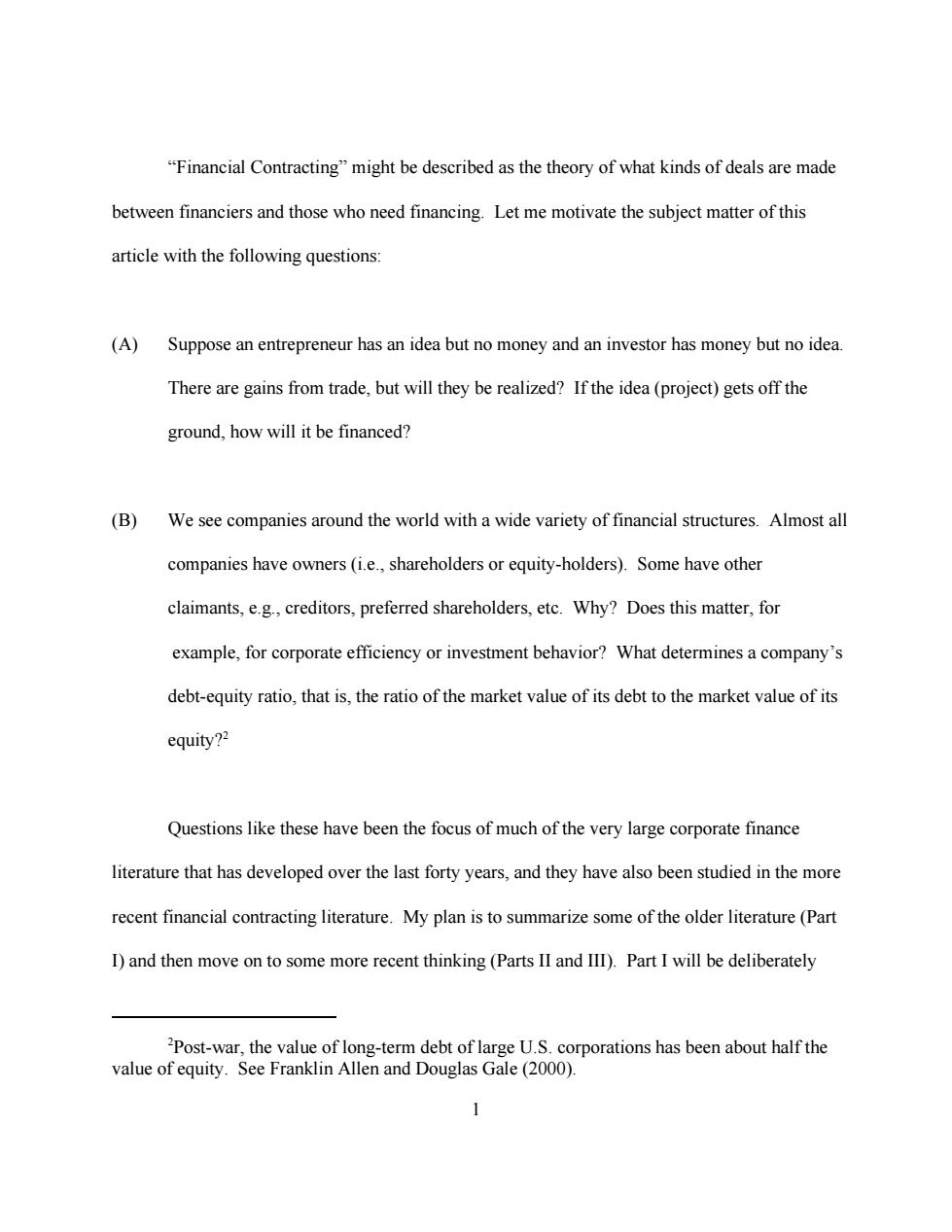
"Financial Contracting"might be described as the theory of what kinds of deals are made between financiers and those who need financing.Let me motivate the subject matter of this article with the following questions: (A) Suppose an entrepreneur has an idea but no money and an investor has money but no idea. There are gains from trade,but will they be realized?If the idea(project)gets off the ground,how will it be financed? (B) We see companies around the world with a wide variety of financial structures.Almost all companies have owners(i.e.,shareholders or equity-holders).Some have other claimants,e.g.,creditors,preferred shareholders,etc.Why?Does this matter,for example,for corporate efficiency or investment behavior?What determines a company's debt-equity ratio,that is,the ratio of the market value of its debt to the market value of its equity?2 Questions like these have been the focus of much of the very large corporate finance literature that has developed over the last forty years,and they have also been studied in the more recent financial contracting literature.My plan is to summarize some of the older literature(Part I)and then move on to some more recent thinking (Parts II and III).Part I will be deliberately 2Post-war,the value of long-term debt of large U.S.corporations has been about half the value of equity.See Franklin Allen and Douglas Gale(2000). 1
2Post-war, the value of long-term debt of large U.S. corporations has been about half the value of equity. See Franklin Allen and Douglas Gale (2000). 1 “Financial Contracting” might be described as the theory of what kinds of deals are made between financiers and those who need financing. Let me motivate the subject matter of this article with the following questions: (A) Suppose an entrepreneur has an idea but no money and an investor has money but no idea. There are gains from trade, but will they be realized? If the idea (project) gets off the ground, how will it be financed? (B) We see companies around the world with a wide variety of financial structures. Almost all companies have owners (i.e., shareholders or equity-holders). Some have other claimants, e.g., creditors, preferred shareholders, etc. Why? Does this matter, for example, for corporate efficiency or investment behavior? What determines a company’s debt-equity ratio, that is, the ratio of the market value of its debt to the market value of its equity? 2 Questions like these have been the focus of much of the very large corporate finance literature that has developed over the last forty years, and they have also been studied in the more recent financial contracting literature. My plan is to summarize some of the older literature (Part I) and then move on to some more recent thinking (Parts II and III). Part I will be deliberately
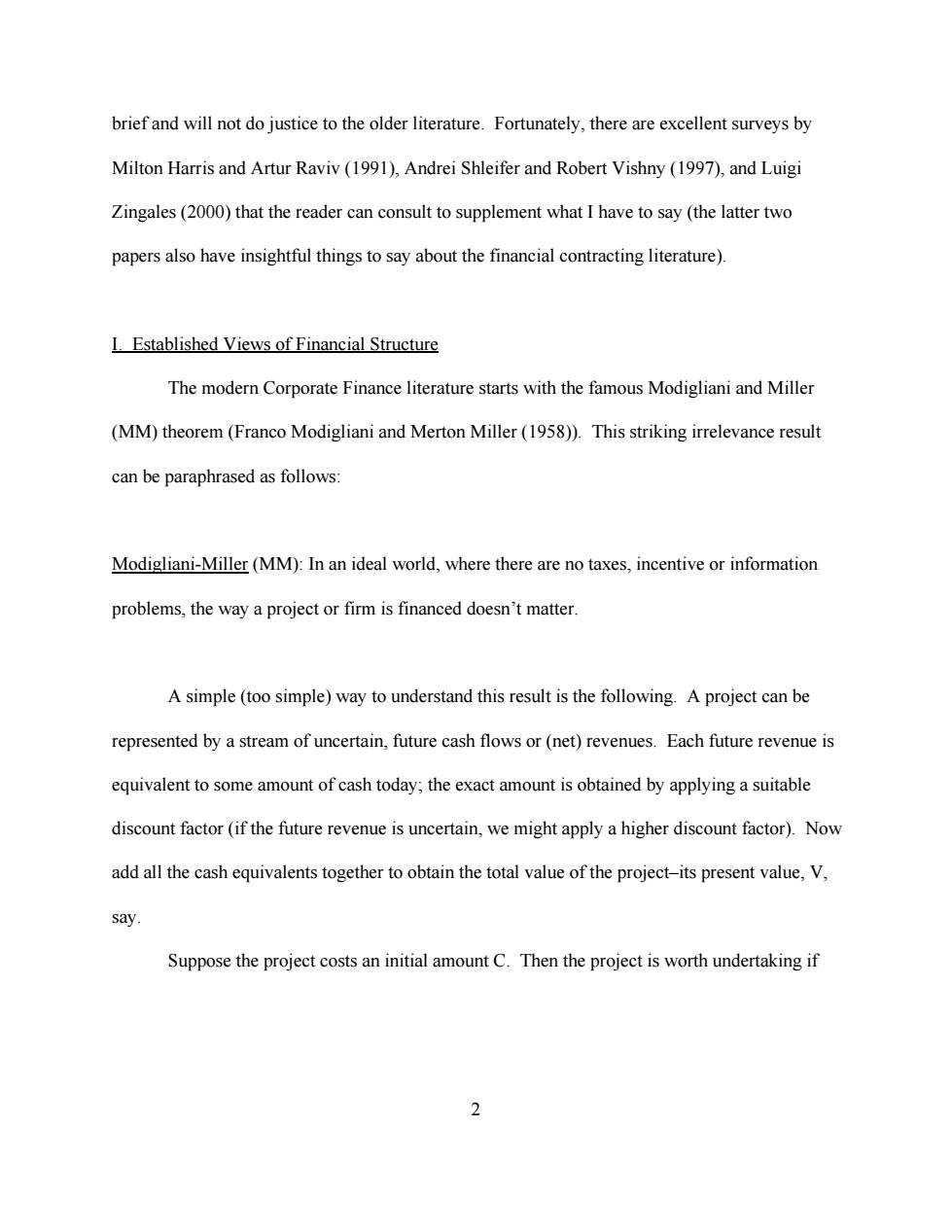
brief and will not do justice to the older literature.Fortunately,there are excellent surveys by Milton Harris and Artur Raviv(1991),Andrei Shleifer and Robert Vishny (1997),and Luigi Zingales(2000)that the reader can consult to supplement what I have to say(the latter two papers also have insightful things to say about the financial contracting literature). I.Established Views of Financial Structure The modern Corporate Finance literature starts with the famous Modigliani and Miller (MM)theorem (Franco Modigliani and Merton Miller(1958)).This striking irrelevance result can be paraphrased as follows: Modigliani-Miller(MM):In an ideal world,where there are no taxes,incentive or information problems,the way a project or firm is financed doesn't matter. A simple (too simple)way to understand this result is the following.A project can be represented by a stream of uncertain,future cash flows or(net)revenues.Each future revenue is equivalent to some amount of cash today;the exact amount is obtained by applying a suitable discount factor(if the future revenue is uncertain,we might apply a higher discount factor).Now add all the cash equivalents together to obtain the total value of the project-its present value,V, say Suppose the project costs an initial amount C.Then the project is worth undertaking if 2
2 brief and will not do justice to the older literature. Fortunately, there are excellent surveys by Milton Harris and Artur Raviv (1991), Andrei Shleifer and Robert Vishny (1997), and Luigi Zingales (2000) that the reader can consult to supplement what I have to say (the latter two papers also have insightful things to say about the financial contracting literature). I. Established Views of Financial Structure The modern Corporate Finance literature starts with the famous Modigliani and Miller (MM) theorem (Franco Modigliani and Merton Miller (1958)). This striking irrelevance result can be paraphrased as follows: Modigliani-Miller (MM): In an ideal world, where there are no taxes, incentive or information problems, the way a project or firm is financed doesn’t matter. A simple (too simple) way to understand this result is the following. A project can be represented by a stream of uncertain, future cash flows or (net) revenues. Each future revenue is equivalent to some amount of cash today; the exact amount is obtained by applying a suitable discount factor (if the future revenue is uncertain, we might apply a higher discount factor). Now add all the cash equivalents together to obtain the total value of the project–its present value, V, say. Suppose the project costs an initial amount C. Then the project is worth undertaking if